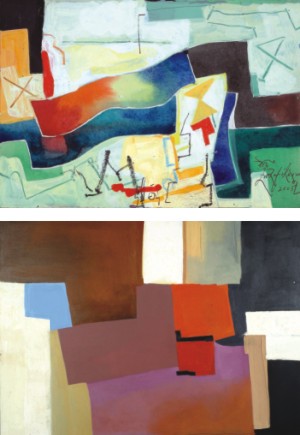|
Art - Peace in the Chaos
Peace in the Chaos
Fayza Haq
 Rafi Haque's recent exhibition at Taj Bengal, Kolkata. A German musician played an instrument while he painted for an entire week, from 3pm to 6pm. "Canvas for me was a new media as I usually work in print. It was encouraging that art lovers lapped up my abstract work. Many local viewers asked me whether I had moved on to abstraction because of religious reasons. I explained that my new expressions were abstract and a development in my stages of painting, bearing no moral grounds. At this time there was an international art symposium, arranged by Taj Bengal, and this helped draw crowds of art lovers and art dealers for my display. Incidentally, on the same day, was the opening of the exhibition of Safiuddin Ahmed's works in the city, so that my press review appeared side by side with that of the great artist, " says Rafi. Rafi Haque's recent exhibition at Taj Bengal, Kolkata. A German musician played an instrument while he painted for an entire week, from 3pm to 6pm. "Canvas for me was a new media as I usually work in print. It was encouraging that art lovers lapped up my abstract work. Many local viewers asked me whether I had moved on to abstraction because of religious reasons. I explained that my new expressions were abstract and a development in my stages of painting, bearing no moral grounds. At this time there was an international art symposium, arranged by Taj Bengal, and this helped draw crowds of art lovers and art dealers for my display. Incidentally, on the same day, was the opening of the exhibition of Safiuddin Ahmed's works in the city, so that my press review appeared side by side with that of the great artist, " says Rafi.
Rafi has been working on the theme of anti- terrorism since 1998. "Through my colours and forms I try to present my protest against war and violence," he says. One of his paintings bear three large overwhelming ovular shapes which stand for bullet holes. Human figures are seen falling chaotically from the top-- defeated in war. The burst of red, seen in the centre, stands for explosion and violence.
Another painting contains nude, female, figures, walking from left to right. "In our present existence, we are rushing, from the time we rise and struggle till we go to bed. We are all in a mad scramble to get somewhere -- which is so obvious when we go out into the streets and see the speeding vehicles. The backdrop appears worn out and burnt up. Our life is full of experiences, both pleasant and otherwise," adds Rafi. "The brown wall stands for our life, full of experiences of all types."
Rafi's more recent paintings contain rectangles -- black, orange, green, gray and blue. "You'll notice that there is no space between the application of the slabs of colours. This is to suggest the cityscape where there is hardly any space between buildings and no room today for parks or playgrounds for children or senior citizens. The expansion of the cities has not been done in a disciplined way," says the artist. Another of his geometrical creations contain more brown and blue rectangles -- along with a little space at the back -- as a form of experimentation.
On another piece we see slabs of blue, pink and black. Below is a dark space containing a white vertical line, which is a symbol of life. "When working I keep my revered teachers Mohammed Kibria and Monirul Islam in mind. I don't imitate them but their work has influence on my work too," says Rafi. Another has a suggestion of a bird -- yet again a symbol of freedom and progress. There are also floating leaves reflecting the passage of time. The female image recurs standing for universal love and inspiration. This bears the influence of Matisse, who is known for his exotic female figures. Shades of greens and yellows are seen in yet another painting suggesting a bird's eye view of fields of crops, with shallow waterways running in between.
"Despite the problems that surround us today, I believe that we will eventually overcome our difficulties. For me the future has hope. It is for us to learn from our mistakes in the past," says Rafi.
Copyright
(R) thedailystar.net 2009 |
